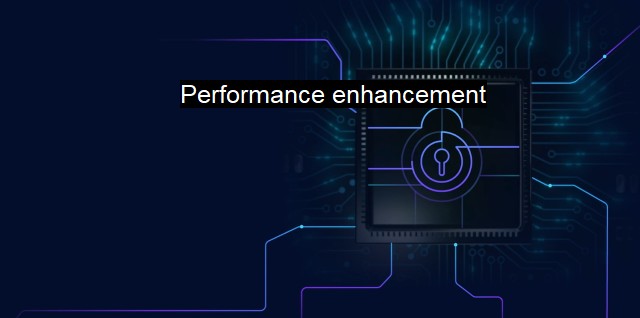What is Performance enhancement?
Achieving a Balance: Performance Enhancement in Cybersecurity and Antivirus
Performance enhancement in the context of cybersecurity and antivirus implies the boosting, streamlining, and improvement of computer or software systems to guarantee optimal operation and robust safety. Cybersecurity systems undergo constantly evolving threats. This necessitates their routine tweaking, reinforcement, and improvement, hence the concept of performance enhancement.The term "performance enhancement" references a broad umbrella of activities designed to make cybersecurity tools like antivirus software more efficient. It points to making changes to guarantee that the software anticipates and handles the ever-growing array of threats like viruses, Trojan horses, ransomware, and many other kinds of malware that lurk in the cyberspace.
At the very core, antivirus software operates by scanning files and system programs to identify patterns or signatures associated with known threats. The security system sorts through data to recognize and depressive dangerous contents, while flagging aspects that are characteristic of the defined malware samples in its repertoire. Once such harmful entities are identified, the antivirus software either quarantines or eliminates them, depending on the severity. This crucial operation of recognition, quarantine, and elimination is where performance enhancement is greatly needed.
Performance enhancement seeks to elevate efficiency, reduce system slowdown and boost system speed. When we talk about elevating efficiency, we refer to ensuring that antivirus software identifies threats with more significant accuracy and gets better at distinguishing destructive elements from innocuous ones. Reducing system slowdown references the drive to make cybersecurity installations as unobtrusive to the system as possible. Ideally, an antivirus should work in the backdrop, consume relatively small system resources, and generate minimal impact on the regular operation of the system.
Enhancing system speed implies ensuring faster scans, especially when dealing with Full System scans that require checking every single file in the system. Ideally, such a scan should be as fast as possible to maintain optimal working conditions for the user. Performance enhancement goes a long way in ensuring accelerated preventive scans, with low to nonexistent interference with the system workflow.
When it comes to real-time protection against threats, performance enhancement involves amplifying the system's knack for recognizing and eliminating threats before they compromise the system. This introduces another level of performance optimization— adaptive response. Developing the reflexes of the system to defend itself against attack attempts on time is a considerable performance enhancement strategy.
Performance enhancement also encompasses updates and proactive response to emerging cyber threat tendencies. Cyber threats are ever-evolving and increasingly sophisticated. They get tweaked and refined by their developers to bypass security measures that, once upon a time, had them in check. This would mean that a antivirus system's enhancement would also involve the monitoring and updating of evolving threats patterns.
Performance enhancement is also looked at from the point of system endurance and strength. It involves fortifying system resistance to brute-force attacks, Distributed Denial of Service (DDoS) attacks, and other system saturation and ‘wear and tear' onslaughts.
Performance enhancement in the antivirus and cybersecurity framework is a vital necessity considering the cyclone of threats that systems face. It is an ongoing struggle for performance maximization, system protection, and threat elimination. This involves several methods such as refining the system’s real-time defensive capacity, system resource management, enhancing scan speed and efficiency, strengthening system resilience, and developing an adaptive control to emerging threats. With the purpose of securing digital systems, enhancing performance practically ensures antivirus software functions optimally.

Performance enhancement FAQs
What is performance enhancement in the context of cybersecurity and antivirus?
Performance enhancement refers to optimizing the speed and efficiency of antivirus software and other cybersecurity tools. This can involve reducing the amount of system resources required to run the tools, improving the speed of virus scans, and minimizing the impact on system performance during scans and updates.How does performance enhancement affect cybersecurity and antivirus software?
Performance enhancement is a critical aspect of cybersecurity and antivirus software because it ensures that these tools can operate quickly and efficiently. Without performance enhancement, antivirus software may run slow or bog down a system, which can leave it vulnerable to cyber attacks.What are some common performance enhancement techniques used in cybersecurity and antivirus?
Some common performance enhancement techniques used in cybersecurity and antivirus include optimizing code for faster execution, reducing memory usage, minimizing disk I/O operations, and using caching and precomputation to reduce scan times. Other techniques may involve leveraging hardware acceleration or parallel processing to speed up tasks.Are there any downsides to performance enhancement in cybersecurity and antivirus?
While performance enhancement is critical to ensuring that cybersecurity and antivirus software operates quickly and efficiently, some downsides to these efforts may include reduced accuracy, higher false positive rates, or less comprehensive scanning. Additionally, some performance-enhancing techniques may require more system resources, which could offset the benefits of faster scan times, for instance.| | A | | | B | | | C | | | D | | | E | | | F | | | G | | | H | | | I | | | J | | | K | | | L | | | M | |
| | N | | | O | | | P | | | Q | | | R | | | S | | | T | | | U | | | V | | | W | | | X | | | Y | | | Z | |
| | 1 | | | 2 | | | 3 | | | 4 | | | 7 | | | 8 | | |||||||